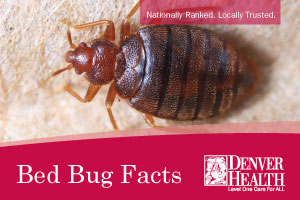Bed bugs are small, flat insects that feed on the blood of people and animals while they sleep. Mature adults are about the size of an apple seed. They are reddish-brown in color and wingless. Download a bed bugs information sheet (Español).
Where are bed bugs found?
Bed bugs exist in all areas of the world, including the United States and can live several months without a meal. They are experts at hiding and their slim, flat bodies allow them to fit into tiny spaces and stay there for long periods of time.
- Bed bugs do NOT live on humans; they usually live in areas within eight feet of where people sleep.
- Common places to find bed bugs include beds and bedroom furniture, mattresses and linens.
- They hide during the day inside seams, cracks or crevices of bed frames and dressers, behind wallpaper, or in any other clutter/objects around a bed.
- The cleanliness of living conditions is NOT a factor in their presence.
Do bed bugs spread disease?
No, bed bugs do not spread disease.
What are the signs and symptoms of a bed bug infestation?
- Visual sighting of bed bugs or their outer shell after molting.
- Dark spotting on walls, mattresses and other places where they hide.
- Rust-colored blood spots due to the fecal material that they excrete on the mattress or nearby furniture.
How do I know if I've been bitten by a bed bug?
Everyone reacts differently to a bed bug bite. Most people do not realize they have been bitten until bite marks appear from one to several days after the bite.
- Bites look like a mosquito or flea bite (slightly swollen, red and itchy).
- Marks may be random or appear in a straight line.
- Skin problems may arise from scratching.
Some people may experience an allergic reaction to several bites. These people may need medical attention. Only 30 percent of people show signs of a rash, which makes detecting them early on very difficult.
How did I get bed bugs?
Bed bugs are usually transported from place to place on people's belongings and their personal body. When people travel the bugs can hide in the seams and folds of luggage, overnight bags, folded clothes, bedding and furniture. Most people do not realize they are transporting stow-away bed bugs as the travel from location to location. Bed bugs can also be found in secondhand furniture and clothing.
Who is at risk for getting bed bugs?
Everyone visiting an infected area is at risk. However, travelers who share living and sleeping quarters with other people have a higher risk of being bitten and/or spreading a bed bug infestation.
How are bed bugs treated and prevented?
Bed bug bites do not usually pose a serious medical threat. The best way to treat a bite is to avoid scratching the area, use antiseptic creams or lotions and take an antihistamine. Bed bugs infestations are commonly treated by insecticide spraying.
If you suspect you have an infestation, contact your landlord or a professional pest control company familiar with treating bed bugs. The best way to prevent bed bugs is to regularly look for signs of an infestation.



